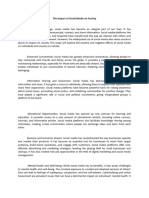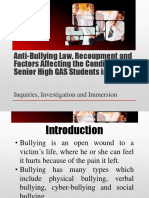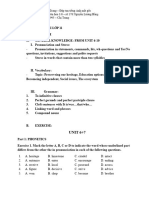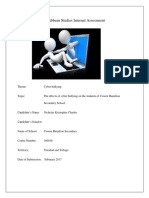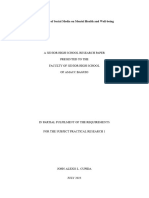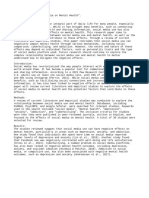The Impact of Social Media: A Double-Edged Sword
In recent years, social media has become an essential part of daily life for millions of people
worldwide. Platforms like Facebook, Instagram, TikTok, and X (formerly Twitter) have transformed
how we communicate, share information, and stay connected. Supporters of social media argue
that it creates opportunities for global connection, enhances business marketing, and encourages
free expression. With just a few clicks, users can interact with people across the world, stay
updated on current events, or even run online businesses. Many students also use social media
to join study groups, access educational content, or find career opportunities. These advantages
have made social media an indispensable tool for many aspects of modern life. It is especially
helpful during times of crisis or emergencies, where news and updates can spread instantly.
Because of this accessibility and convenience, it’s easy to understand why many people view
social media positively.
However, critics argue that the negative effects of social media often outweigh the benefits. One
of the main concerns is that social media can have harmful impacts on mental health. Studies
have shown that excessive use of platforms like Instagram or TikTok can lead to feelings of
loneliness, anxiety, and depression—especially among teenagers. The constant comparison to
others’ carefully curated posts can lower self-esteem and create unrealistic standards of beauty
or success. In addition, social media addiction is becoming more common, with users spending
hours scrolling without any productive outcome. This addiction can interfere with real-life
relationships, academic performance, and even sleep. Another concern is cyberbullying, which
has become easier and more frequent due to the anonymity provided by social media. Victims of
online harassment often suffer emotional distress, and in extreme cases, it can lead to tragic
consequences. Therefore, many argue that the risks to mental and emotional health should not
be ignored.
Moreover, the spread of misinformation is a serious problem on social media platforms. False
news, conspiracy theories, and misleading content can spread faster than verified information. In
the age of social media, anyone can post anything without fact-checking, which can lead to
confusion and fear. For example, during global crises such as pandemics or elections, misleading
information on social media has caused panic, influenced public opinion unfairly, and even
affected people's health choices. Although platforms have started to implement fact-checking
systems and content moderation, they often struggle to keep up with the vast amount of content
shared every second. This lack of control can be dangerous in a world where many people rely on
social media as their main source of news. Without proper regulation, social media risks
becoming a breeding ground for propaganda and manipulation. As a result, some believe
stronger laws or restrictions are needed to control false information online.
On the other hand, social media has provided a voice to people who were often silenced in
traditional media. Marginalized groups, activists, and independent creators now have a platform
to express their opinions and share their stories. Social media has played a key role in organizing
social movements, raising awareness about injustice, and promoting equality. For instance,
hashtags like #BlackLivesMatter and #MeToo went viral and led to real-world discussions and
changes. This kind of digital activism would not be possible without the power of social media.
Additionally, small businesses and independent artists use social platforms to reach a larger
audience and earn income. These opportunities have helped many people improve their lives in
ways that weren’t possible before. So, while social media can be harmful, it also empowers
�individuals and communities in meaningful ways.
Another advantage of social media is its role in education and information sharing. Many
educators, students, and professionals use platforms like YouTube, LinkedIn, and Reddit to learn
new skills, share knowledge, and network with others in their field. Online courses and tutorials
have made learning more accessible and flexible for people of all ages. During the COVID-19
pandemic, social media and video conferencing tools became essential for remote learning.
Although some distractions exist, social media’s educational potential is clear when used wisely.
Teachers and students can collaborate more easily, access learning resources, and engage in
discussions beyond the classroom. These tools also help bridge the education gap between urban
and rural areas. As long as users approach these platforms with a critical mind, social media can
serve as a powerful educational tool.
Despite the many benefits, the overuse of social media can negatively affect personal
relationships. People may become so absorbed in their screens that they ignore real-life
interactions with family and friends. It’s common to see groups of people sitting together, each
focused on their own phones instead of talking to one another. This behavior can weaken
emotional bonds and create feelings of isolation. Moreover, social media often encourages
shallow communication—likes, emojis, and short comments—rather than deep and meaningful
conversations. As a result, some psychologists warn that digital interactions can never fully
replace face-to-face connections. If people don’t learn to balance their online and offline lives,
they may lose important social skills over time. Therefore, healthy boundaries are essential when
using social media in order to protect personal relationships and well-being.
In conclusion, social media is a powerful tool with both positive and negative effects. On one
hand, it allows people to connect, learn, grow businesses, and fight for social justice. On the
other hand, it can harm mental health, spread false information, and damage real-life
relationships. The key lies in how individuals choose to use it. Governments, educators, and
families must work together to raise awareness about responsible social media use. While it is
unrealistic to eliminate social media entirely, it is possible to promote healthier habits and digital
literacy. With the right balance, social media can continue to be a valuable part of modern
society—without causing harm to its users. Ultimately, like any powerful tool, social media should
be used with care, awareness, and responsibility.
Do it by yourself !
Advanced Essay Questions: Argumentative Text on Social Media
1. Evaluate the statement: "The benefits of social media outweigh its drawbacks."
Use specific examples from the text to support your opinion, and consider both the positive and
negative impacts discussed.
2. How does the text present the issue of mental health in relation to social media use?
Analyze the arguments made, the evidence provided, and discuss whether the author’s concerns
are valid in today’s digital environment.
3. Discuss the role of social media in spreading misinformation.
How does the text explain this problem, and what potential solutions could be implemented to
reduce the spread of false information?
4. In what ways does the text argue that social media empowers marginalized voices and social
movements?
�Provide examples from the text and critically assess whether this empowerment is sustainable or
temporary.
5. Examine how the author balances both sides of the argument regarding social media.
Do you think the text presents a fair and balanced view, or does it lean more towards one side?
Justify your response with references to the text.
6. What role does education play in the responsible use of social media, according to the text?
Discuss how digital literacy and awareness can influence the impact of social media on individuals
and society.
7. Compare and contrast the effects of social media on personal relationships versus its impact
on business and professional life.
Which area is more affected, and why?
8. Social media is often described as a "double-edged sword." Based on the text, do you agree
with this metaphor?
Explore the strengths and weaknesses of this comparison, using examples from the reading.
9. Propose a set of guidelines for healthy social media use based on the concerns and solutions
mentioned in the text.
Your answer should include both personal responsibility and the role of institutions like schools
or governments.
10. To what extent should governments regulate social media content, particularly in terms of
misinformation and harmful behavior?
Use arguments from the text to support your position, and consider the balance between free
speech and public safety.





























